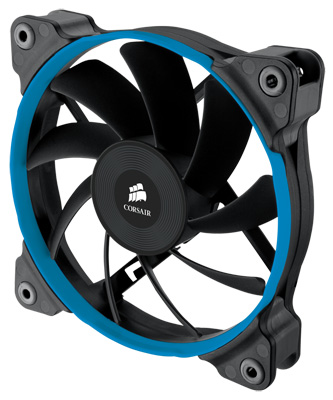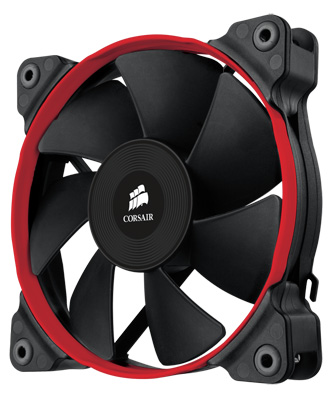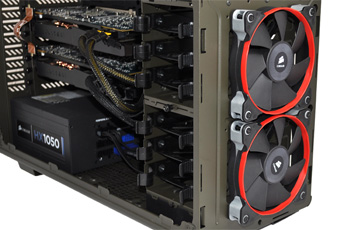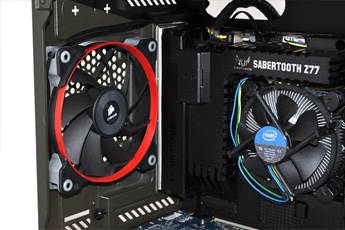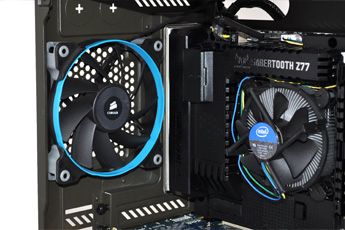Introduction
What are the chances of you using a Corsair product in your next PC build? Quite high, we'd imagine. Having first made its name as a memory manufacturer, Corsair has in recent years branched out successfully and, right now, you could quite easily recommend a Corsair power supply, chassis, CPU cooler, SSD and memory to anyone putting together a quality PC.
And why stop there? Following on from the launch of various gaming peripherals and audio products, Corsair's now expanding the reach of its cooling department with the introduction of Air Series Fans.
Designed to offer "an extraordinary balance of airflow and low-noise for quieter operation and higher performance," these blowers come in various shapes and sizes suited to unique roles.
The AF series (pictured above, left) is configured to offer high air flow from nine blades, while the SP series (pictured above, right) is equipped with seven ultra-wide blades that are geared toward creating high static pressure that aids air flow in tight spots, i.e. when up against a heatsink or radiator.
It's easy to differentiate between the core AF and SP lines, but there a couple of other factors to consider. Both series are available in a choice of 'Performance' or 'Quiet' editions, with the former offering higher speeds and the latter sacrificing rotational speed in an effort to reduce noise. And, while all of the aforementioned are available in a standard 120mm form factor priced at around £13, the AF series also extends to a larger 140mm Quiet Edition model, currently retailing for £15.
AF120 Performance Edition |
AF120 Quiet Edition |
SP120 High Performance Edition |
SP120 Quiet Edition |
AF140 Quiet Edition |
|
|---|---|---|---|---|---|
| Size | 120mm x 25mm |
140mm x 25mm |
|||
| Operating Voltage | 7V – 12V |
||||
Performance at 12V |
|||||
| Airflow | 63.47 CFM |
39.88 CFM |
62.74 CFM |
37.85 CFM |
67.80 CFM |
| Static Pressure | 1.10 mm/H20 |
0.50 mm/H20 |
3.10 mm/H20 |
1.29 mm/H20 |
0.84 mm/H20 |
| Sound Level | 30 dBA |
21 dBA |
35 dBA |
23 dBA |
24 dBA |
| Speed | 1,650 RPM |
1,100 RPM |
2,350 RPM |
1,450 RPM |
1,150 RPM |
| Power Draw | 0.13 A |
0.08 A |
0.18 A |
0.08 A |
0.10A |
Putting all of the variables in an easier-to-digest table makes the buying decision that little bit easier. In a nutshell, the SP120 is Corsair's go-to fan for restricted places (for example behind a radiator, heatsink or drive cage) and the AF120 is ideal for use as a regular chassis fan (intake or exhaust). Each fan is equipped with a couple of valuable features, too, including a hydraulic bearing that promises to be "quiet and reliable," vibration-absorbing rubber corners, a voltage step-down adaptor that further reduces operating speed, and interchangeable ring inserts that allow you to customise the fan to red, blue or white.
The fans feel well built and sturdy, but they're backed by a relatively-limited two-year warranty - in comparison, rival manufacturers aren't shy in backing their fans for periods of up to six years. A longer warranty would add piece of mind, but we do like the fact that Corsair's interchangeable rings make it easy to maintain the look of your build. The coloured rings can be removed entirely to leave a black-and-grey finish, and we suspect the inserts will prove popular with modders - they're ideal for custom paint jobs.
A solid introduction for the range, then, but Corsair could go one or two steps further. We found the fan cables to be infuriatingly short (installing the fans as front intakes on Corsair's own Vengeance C70 chassis was tight) and we'd have preferred braided cables for aesthetics' sake. Of course, if you've a thing for LEDs, you may also rue the fact that Corsair has opted not to illuminate any of the Air Series fans.
The fans score well in the looks department, and we've setup two unique configurations to see how they perform. For the first test, pictured above, we've swapped out the Vengeance C70's three default fans for two SP120 High Performance Edition intakes and an AF120 Performance Edition exhaust, all dolled up in red.
To get an idea of the trade-off between Performance and Quiet editions, we then swapped the three fans for two SP120 Quiet Edition intakes and an AF120 Quiet Edition exhaust, as pictured below.
They look the part, but do they make any real difference to component temperature and system noise?






